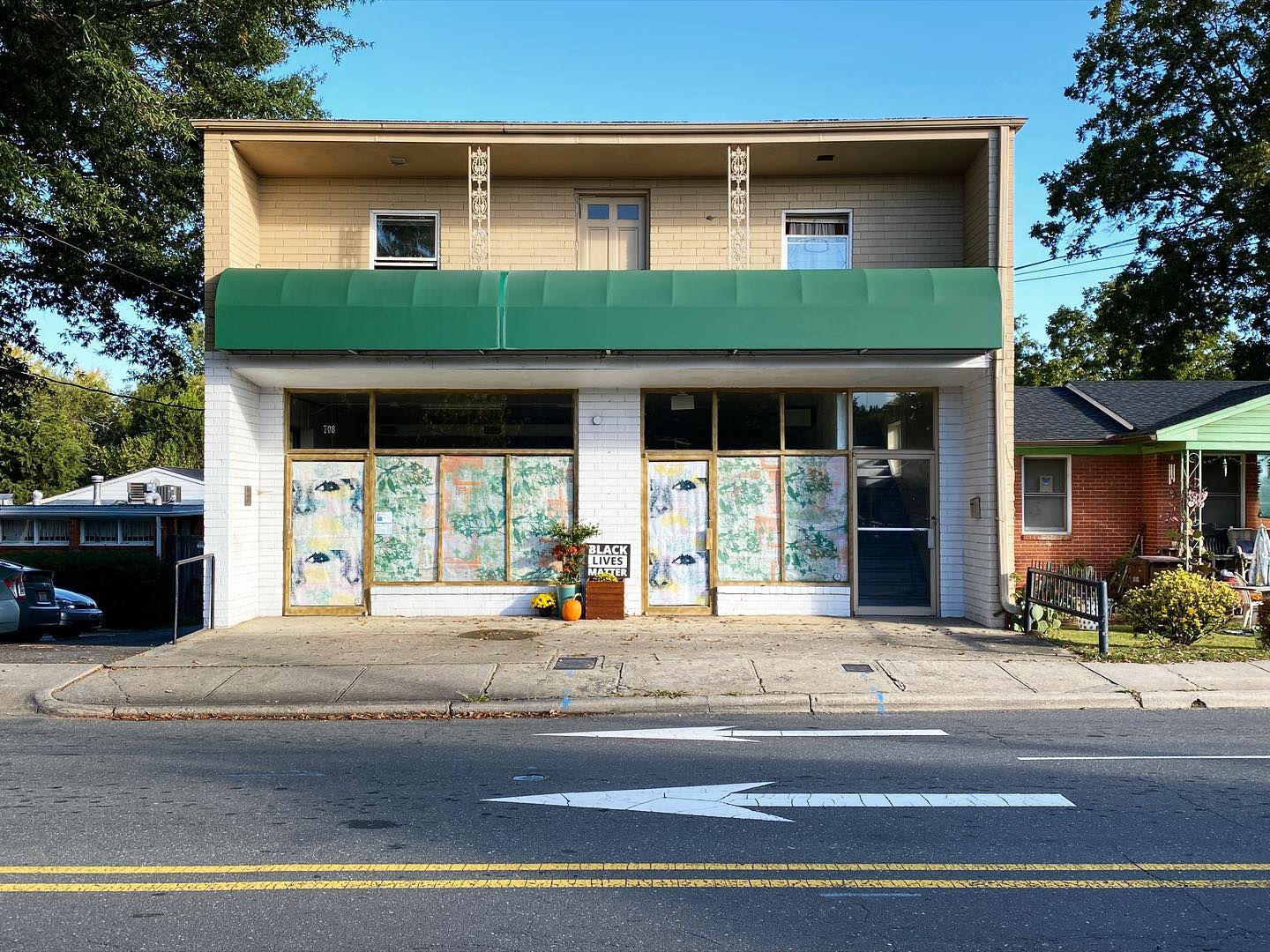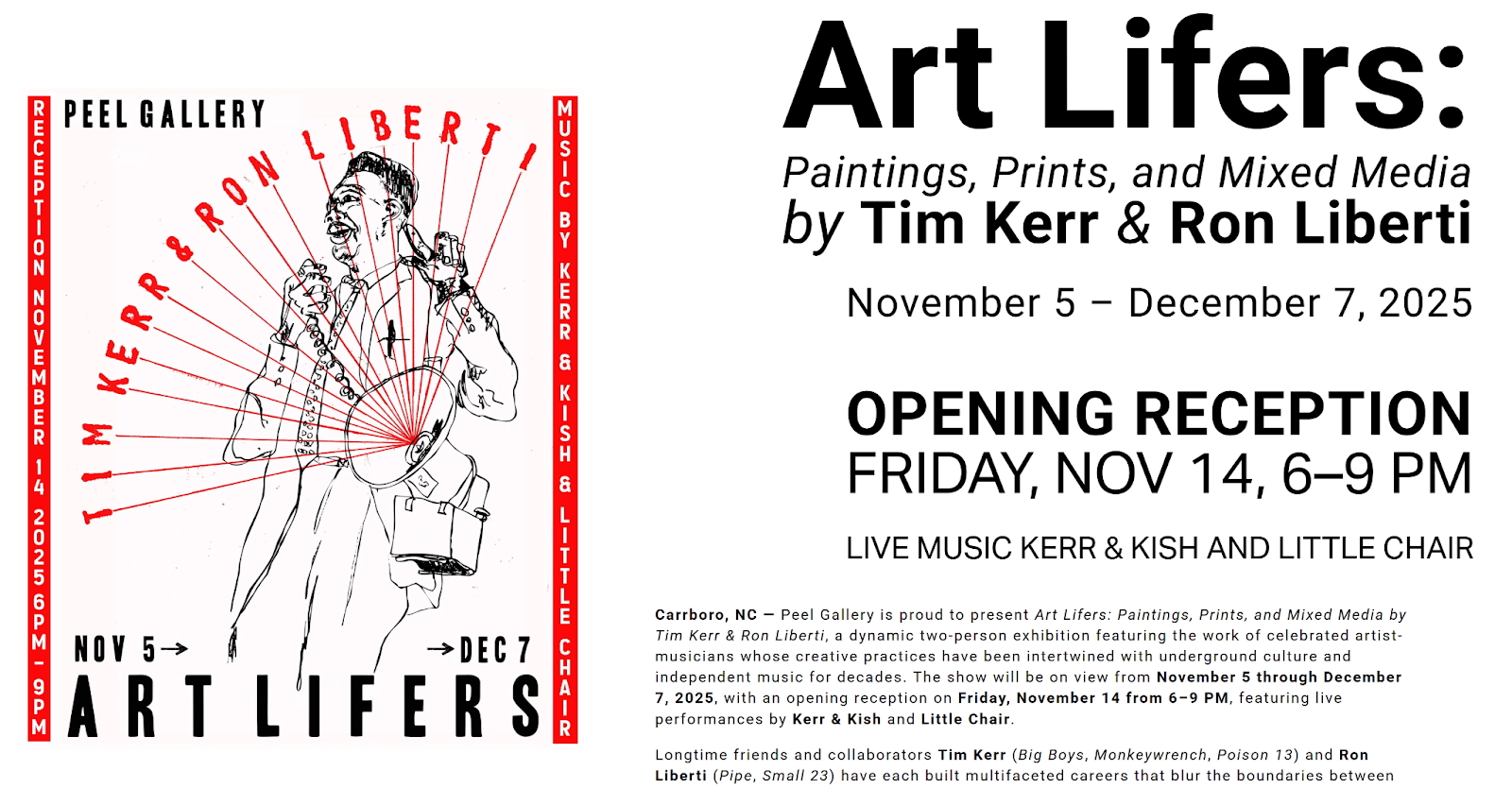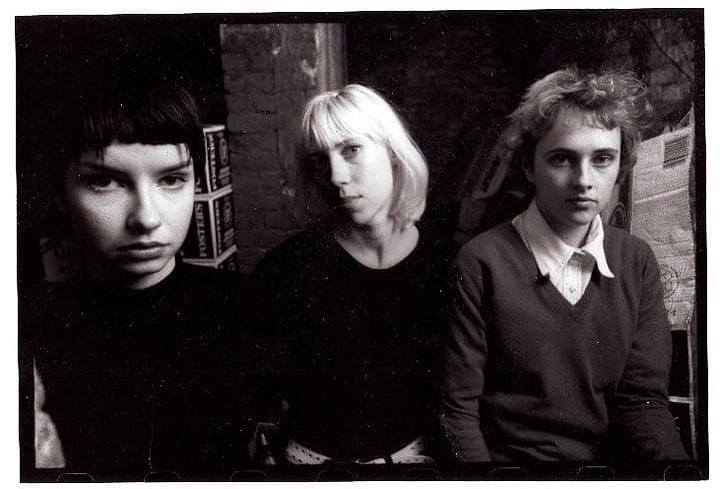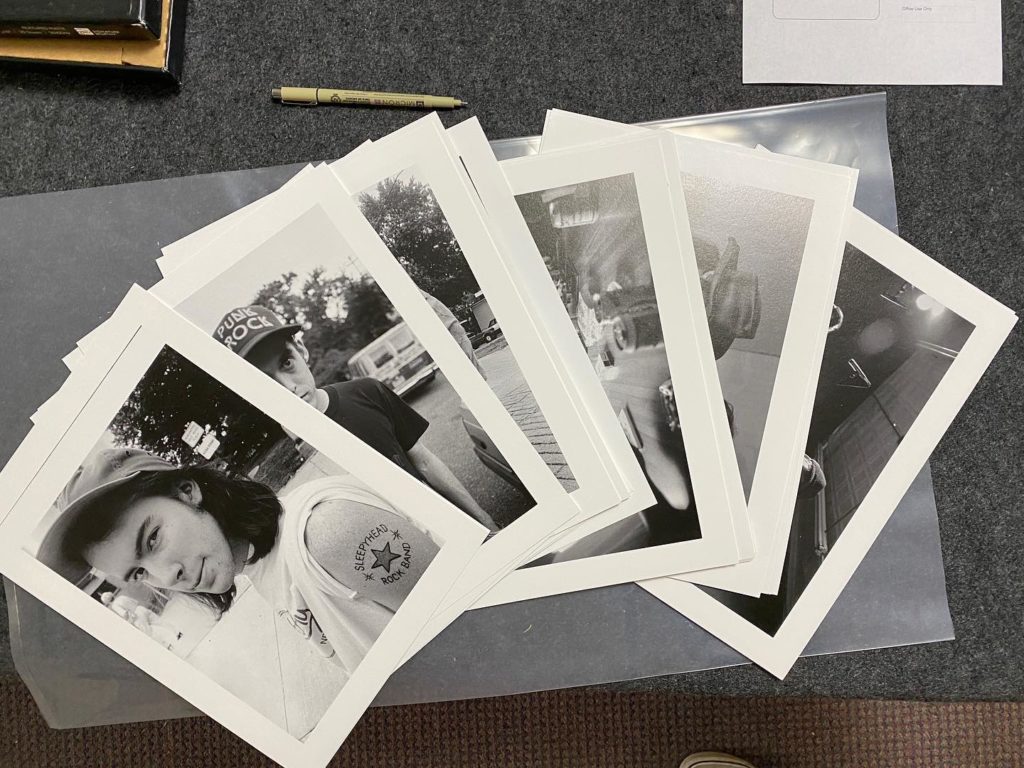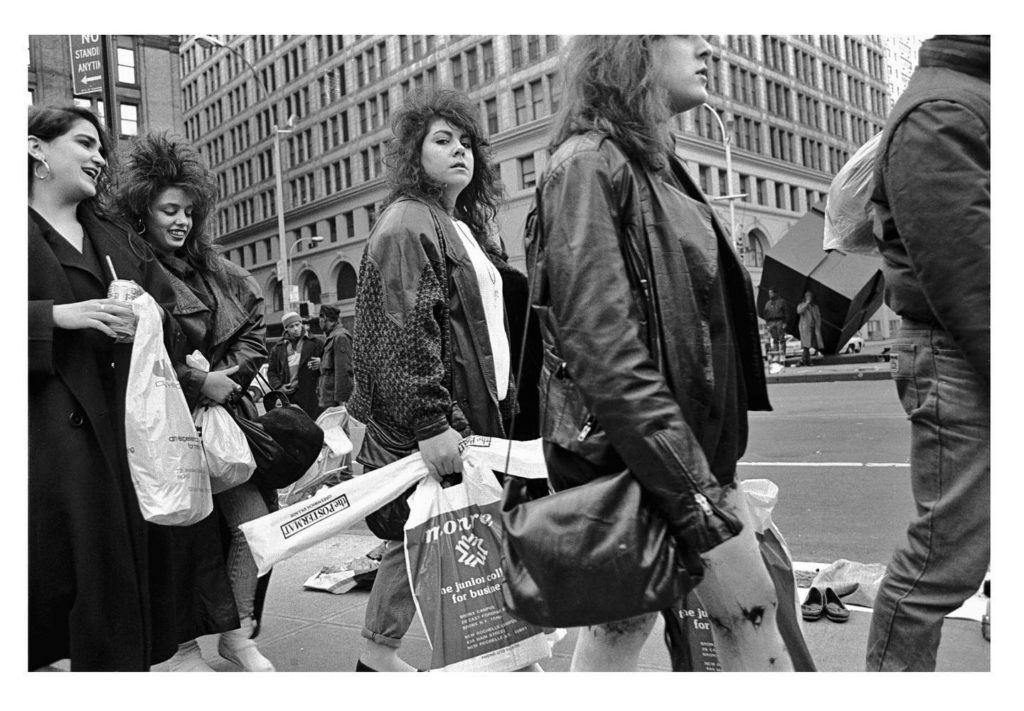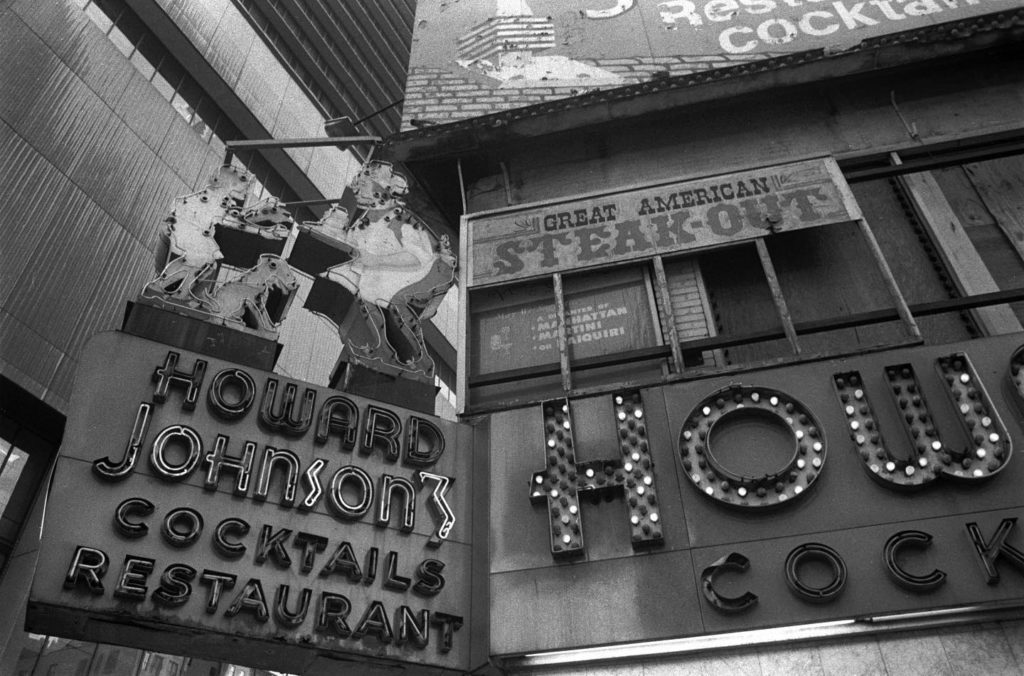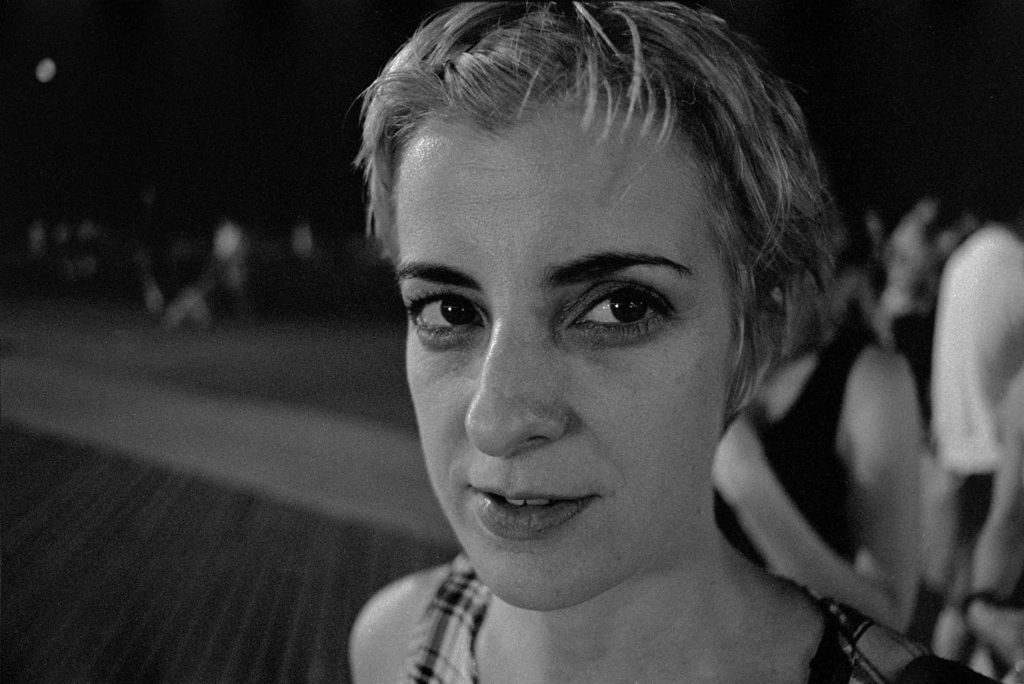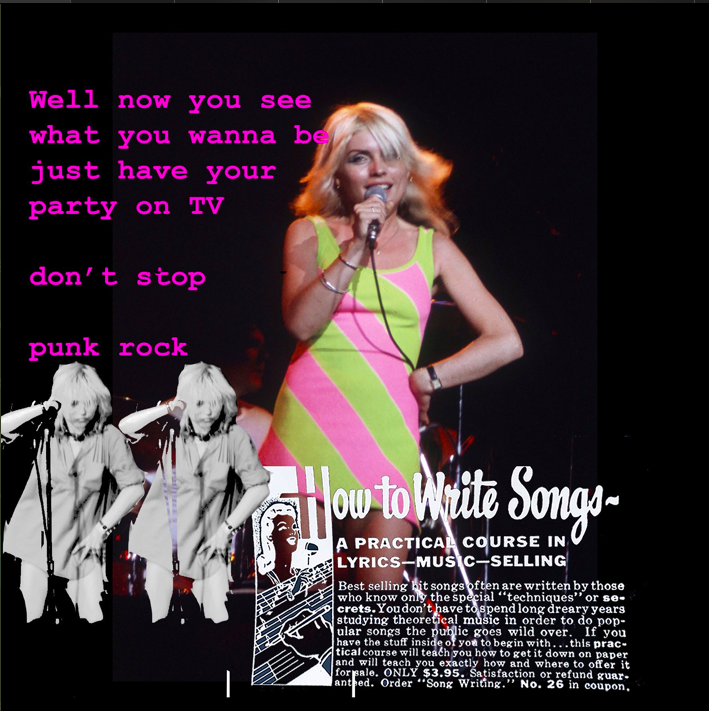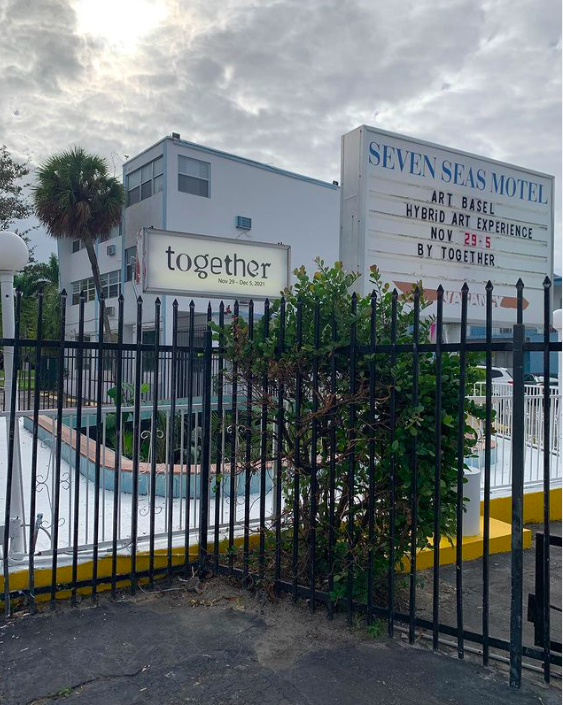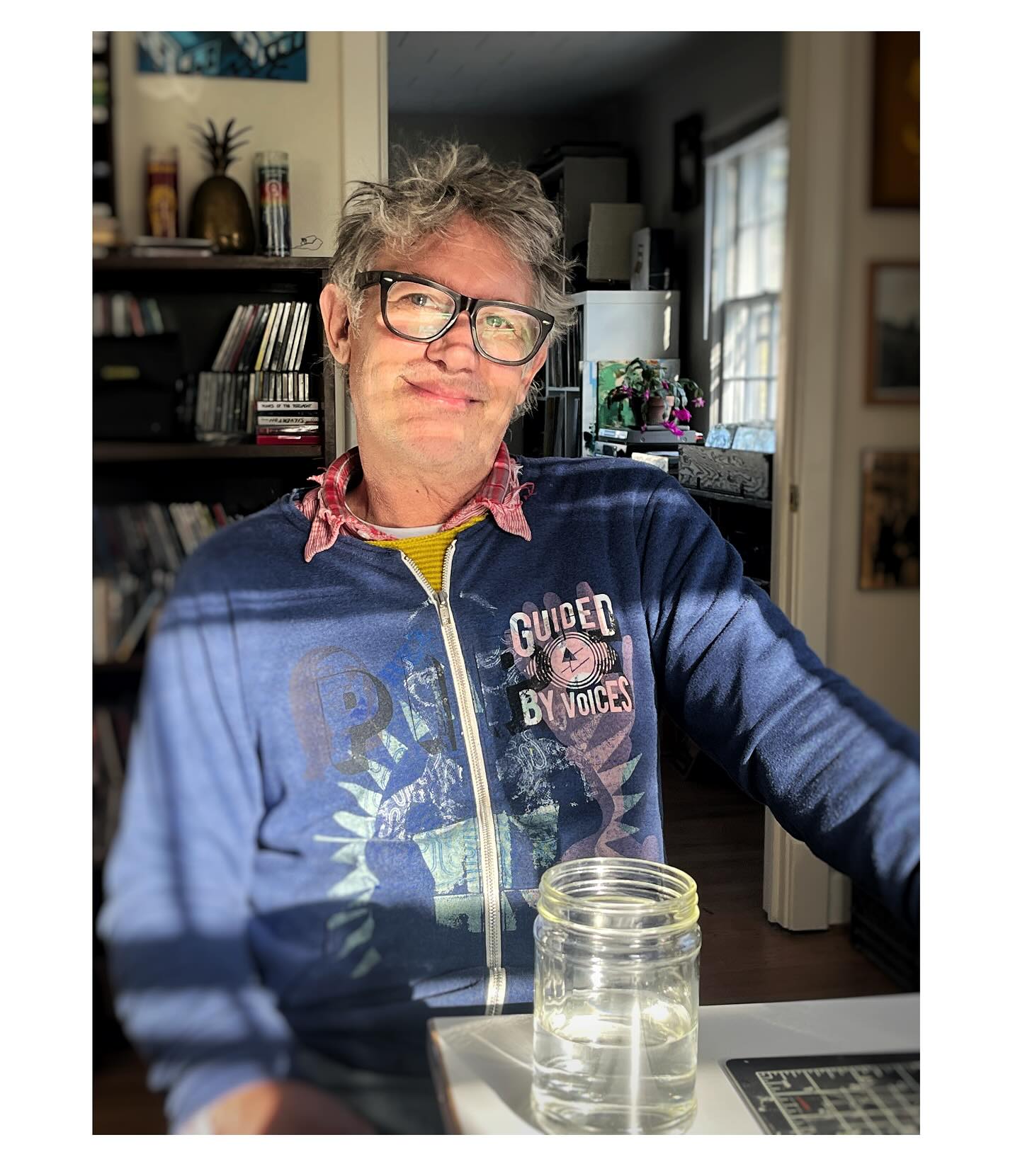
If you’ve ever been to Chapel Hill, chances are you’ve seen a Ron Liberti poster, the kind you want to own after you see it. Our Triangle correspondent Gavin O’Hara sat down with the artist-musician-poster designer extraordinaire to catch up in advance of his new art exhibition opening Nov. 5 at Peel Gallery:
I can vividly remember the day I met Ron Liberti. It was late summer 1992 and I had just moved to the venerable college town of Chapel Hill, North Carolina. I was 25 and in search of my people. I wandered into the Hardback, a left-of-center bookstore and cafe. Ron was standing behind the bar wearing a cardigan and a rumpled white t-shirt. He greeted me with a smile that seemed both menacing and kind. I chatted him up, ordered the first of many $1.25 iced coffees (free refills!) and settled into a place that would become the center of my life.
With the benefit of hindsight, I like to think Ron was an ambassador put there by some higher power. Our friendship developed and the Hardback became my portal into a remarkable town with a weirdly compelling history of Southern subversiveness. There were artists, musicians, aficionados, weirdos, runaways and castoffs who knew this was the only place for miles around where they could truly become themselves. It was breathtaking. The town’s core identity still endures to this day but it’s different in a million ways too. Thankfully, Ron Liberti isn’t. Turns out he’s an art lifer. (Images courtesy of Ron Liberti and Michael Galinsky)
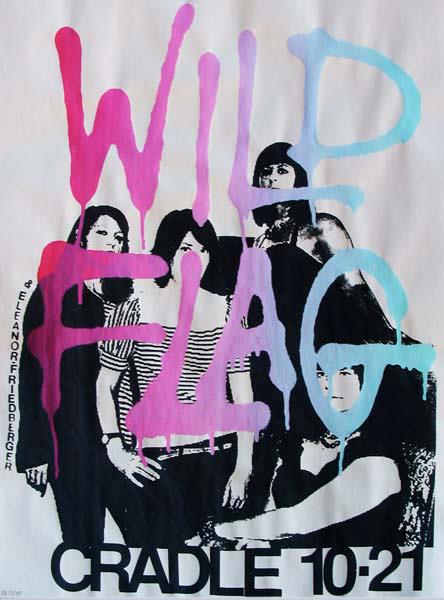
chickfactor: What was the best thing about growing up in New Jersey?
Ron Liberti: One best thing is tough. The food (pizza, pork roll egg and cheese on a hard roll, diners). I had lots of friends in my little neighborhood, that was pretty great, playing sports in the street, running wild, riding skateboards, fucking around, all that fun kids stuff. I had lots of relatives up north Jersey. My parents’ brothers and sisters were cool but my grandparents’ brothers and sisters – especially on the Italian side – were awesome. Uncle Dominic, Uncle Sally, Uncle Vito, Aunt Millie, Aunt Annette all turned me on to great stuff: Sinatra, listening to baseball on the radio, being a sharp dresser, the joy of a good tomato or nice ripe fig, Tony Bennett, letting me drive their Cadillac’s and Lincoln’s (under age) and them just being cool old people really made an impression on my young soul.
Once I moved down the shore I really got into skateboarding/surfing and the whole boardwalk/beach culture and that’s where I got turned on to punk rock, girls, drink and drugs, ya know, pushing boundaries and basic juvenile delinquent behavior. The close vicinity to Philly and NYC was cool and fun too. It was not uncommon to hop a bus to the big town for an afternoon or skip school to go see Van Halen at the Spectrum. I also took offense to NJ’s reputation with the rest of America. All they see is the industrial wasteland from Newark Airport to Manhattan, but people that actually live there know how beautiful and diverse it really is. It’s called the Garden State after all and some of the greatest artists, athletes, musicians and upright citizens are NJ natives. I’m proud to be from NJ and, even though I chose to leave, I’ll always love it. It formed who I became and I’m forever grateful I grew up there. It’s in my blood.

Tell us about high school Ron. Were you popular? Did you find your people at school? I know you played soccer. You mentioned you started to recognize your art talent around then and started to find solace, camaraderie and inspiration in music as well–how did all that impact you?
I liked high school a lot. Not necessarily my classes, except for art and gym, but I was pretty good at the social part. I had many friends and a variety of them too. I was able to hang out with the jocks (I played soccer, basketball and baseball), the cinders (I cracked them up, was able to keep up with them on the party front and loved classic rock like the Who, the Stones, Neil Young, Led Zep, Sabbath, Pink Floyd) and the freaks (always interested in alternative music like the Cure, Echo and the Bunneymen, Violent Femmes, Ramones, Devo, Cramps, R.E.M.).
Art and living the art life was on my radar from an early age. I found being in art class, surrounded by open-minded, forward-thinking, interesting people doing their own thing made me feel like my true self and I wanted to keep feeling that way. Some of my best friends to this day are people I met at Toms River High School North. Go Mariners!

It’s 1986. Paint me a picture of being an art student at Montclair State College. It’s like 10 miles from Hoboken and Manhattan—you must have been on fire. What vivid music or art memories do you have from that impressionable age?
Mudflap haircut, hanging at the art building, going into Manhattan for museums, art openings, dive bars, drinking 40’s out of paper bags, going to shows and other exciting events. Maxwell’s was an integral part of my college life, we went there all the time and I saw some of the greatest shows of my life. Being so close to the stage, as opposed to nose-bleeding for Van Halen or Pink Floyd at the Spectrum, completely blew my mind. The Feelies, The Gories, Dino Jr, Bongwater, Alex Chilton. Too many to name, but seeing and feeling these bands really set me on my path.
I was also a radio DJ at WMSC, which I loved doing and turned me on to all sorts of new music but being so close and tuning in to WFMU, that then was at Upsala College in E. Orange, really influenced me by turning me on to more experimental sounds and aural experiences that expanded my knowledge and possibilities of thoughts and sounds. They played talks by people like Alan Watts and Terrence McKenna, all kinds of sound collages, John Cage, Harry Partch, outsider sounds by the likes of Jandek and Daniel Johnston, Half Japanese and good ole punk rock! FMU turned me onto Superchunk. I went to check them out at Maxwell’s and again the next night at the Knitting Factory….a year(ish) later I was living in Chapel Hill. I also have to shout out all the killer oldies stations up there which I also loved, especially WNEW. I especially dug Dion, Francis Albert Sinatra and Elvis Aaron Presley, Buddy Holly, Gene Vincent etc.
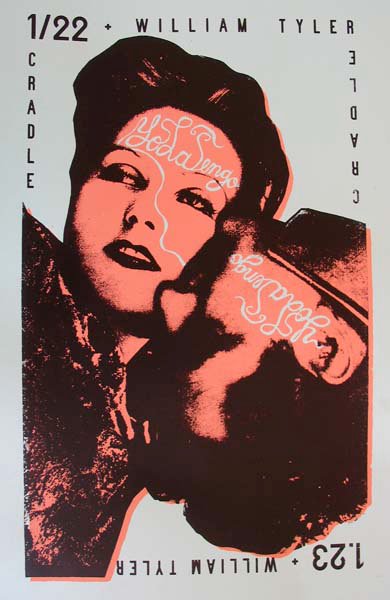
You had a UK and Euro adventure in 1988. What was in your tapedeck at that time? What did you eat? What did you drink? What did you wear? Were you fashionable?
We listened to The Smiths, R.E.M, Billy Bragg, Jesus and Mary Chain, Jonathan Richman, Pixies, Galaxie 500. We ate mostly potatoes, which we had delivered to our cold and janky flat. We drank coffee, tea, pints of beer and snakebites (half cider, half lager). We dressed like art students straight out of Central Casting: mudflap hairdos, mostly black clothes and thrift store cardigans, many layers. Stinky and awesome were we. I thought I was fashionable. I got laughed at less in the UK than by the guidos in N.J. who didn’t think twice about throwing out a “hey faggot” or some other clever quip. I got over that shit quickly and, luckily, in due time I found many more kindred spirits in Chapel Hill.
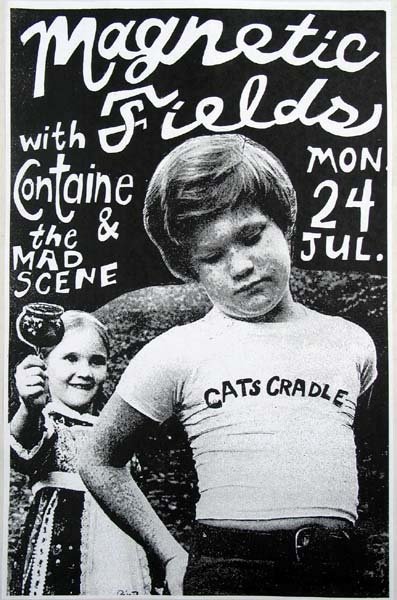
Back in Montclair, you started Love Onion with future PIPE bandmate—and Durham chef—Dave I.T. Was that your first band? Did you step up to the mic right away or were you playing other instruments?
Yes, Love Onion was my first band. I had played trumpet in elementary school and got my first guitar in high school, which I messed around with but ultimately pawned to go on a roadtrip to New Orleans. I scored another one from a dumpster in college when I returned from England, about the same time as Love Onion started, and was more inspired to play, mostly by my talented new friend David Alworth, who also showed me some basic chords and how they work together. I got a big muff and made mostly noise but was hooked. I played guitar on a couple Love Onion songs but really bonded with Pete and Kathy, the other two singers in the band, we sounded good together and cracked each other up. It was fun and entertaining and I think people liked it. I personally didn’t like my voice very much so it was nice to have buffers. I really wanted to be the Bernie Taupin of the band but they weren’t having it. Once I got my stage chops I felt more comfortable, then it kinda took over and the next thing you know…
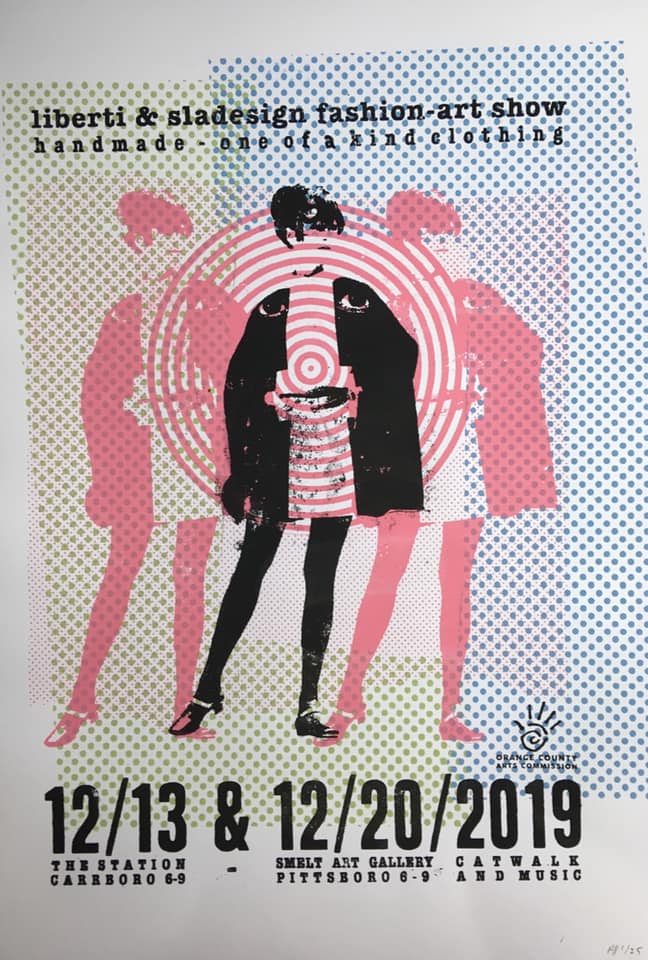
Did Love Onion really play on WFMU?
Yes! I have the tape around here someplace. It was the first time we really heard what we sounded like and what we were saying. We really dug it! We were also part of a Thomas Edison tribute record FMU put together. We did a song we called “Hair Cigar,” which was about a story someone heard about Edison rolling cigars with hair in them as opposed to tobacco to fuck with his workers who were stealing his real stogies. My art life and music world collided at this point and I started making posters for our shows. My future was coming into focus.
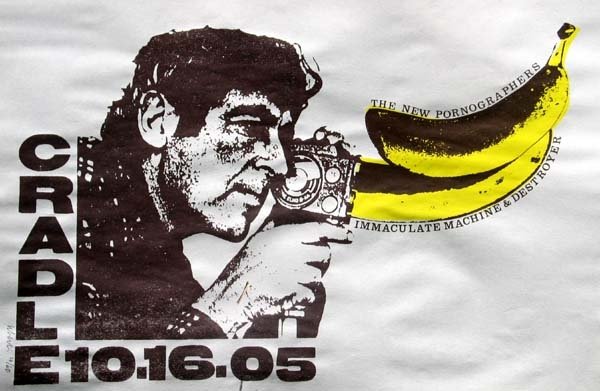
I love asking people this even when I’m not interviewing them—how did a nice boy like you end up in Chapel Hill in 1991? What are your first memories of the place—like, what captivated you? And what kept you here after that initial thrill wore off?
In 1989 Dave I.T., a couple other friends and I took a road trip to Graceland and on our way back to NJ came to visit Mike Kenlan, who had moved down a couple years prior. We knew Mike from Montclair. We all worked at the same used bookstore where “books are good” and he was a fan of Love Onion which meant a lot coming from such a badass. He was living in a cool ass house on Carr St, screened in porch, nice yard, walkable to downtown and the Cradle and paying less than I was paying to live in a small apt. above a liquor store in NJ. It was springtime too, one of those days where the red buds just started blooming and people were outside, frolicking, partying, hanging and seemingly happy to just be alive. Meanwhile back in NJ it was still freezing cold, big piles of black plowed snow not even close to thawed…fuckin’ brrrr.
Through Mike we also knew about the supportive and awesome music scene. He had sent us a mixed tape with Zen Frisbee, Metal Flake Mother, Polvo, Superchunk etc, which I wore out. Chapel Hill—its people and energy—really charmed me and made a great impression. The hook was in. After graduating with a degree in fine art and a minor in film I soon realized I was gonna have to be a bartender, or get some sort of job to make ends meet. Remembering the wonderful time we had in Chapel Hill, the cost and ease of living, plus the music and weather….and honestly looking for a change…next thing you know Dave I.T. and I are loaded and rolling, heading south towards our new home and destiny. As much as I knew I was gonna miss my dear friends and family I was excited and nervous but felt confident in the move. I think we both were thinking maybe grad school, but once I settled in, got a job at the Hardback Cafe (where I made some of the best and longest friendships of my life including yourself) and started working on music, making posters and helping to book bands it all came into focus. Next thing you know it’s 34 years later and luckily I still love what I do.

For people who weren’t there, how would you explain what the Hardback Cafe meant to our mini-generation in that moment?
The Hardback was a fantastic hangout, meeting place, live venue, half-bookstore, half-coffee shop restaurant that employed all sorts of musicians, artists, students, local lifers, hipsters and slackers. It was an invigorating and inspiring place to be, playing backgammon, nursing iced coffees until it was beer o’clock, usually around 4 or 5 pm. Dreaming, scheming and planning for a better tomorrow. Drinking, thinking, loving and learning. I miss that place all the time and still feel fortunate and thankful to Jamie McPhail for giving me a job and Alvis Dunn for teaching me how to be a good bartender, better citizen and stand up Chapel Hillian. You totally got it, all of it, and I knew from the first time I met you that you were a good egg and one of us.

It wasn’t long before I saw you do your thing onstage. I’ve had love affairs with a lot of Chapel Hill bands over the years but I have only one favorite and it’s PIPE. That Ball Peen EP is a lost classic and you guys said more in a 12-song, 21-minute live show than the rest of us said in our whole lives. How the hell were you always able to streamline your songs into such powerful statements?
Not tons of people got into us over the years but the ones that did really dug it so I knew we were doing something right. I guess we always try to keep it concise, everyone giving their all, emoting our feelings with a blast of energy and honesty. And once we get it out, if done correctly, no need to dwell on it.

Your shows in recent years are just as impactful as ever.
Surrounding myself with such incredible musicians in PIPE (David Alworth, Mike Kenlan and Chuck Garrison) really inspires me to try my hardest and give it my all every single time we hit the stage or write a song. I literally could not do what I do without them and feel lucky and honored to have shared a stage and made those records with them for all these years.

Side question: you once jumped off the stage of the Local 506 and landed on me, dislocating my shoulder. I am still waiting for an apology. Thoughts?
Holy shit! I’m so sorry about your shoulder, my friend! I’ve said it before, I really turn into a different person when I hit the stage with PIPE. The energy and sound takes over and I just have to get it out! It’s not quite a blackout but it is a blur. I think I’m such an upstanding citizen (at least I try to be) because I’m able to release whatever built-up tension has accumulated in my life, therefore I don’t need to be walking around screaming at people for whatever bullshit they lay on us. And it’s not all anger, we have a blast doing it and hopefully that comes across more than just being pissed off about everything. We are definitely not that. And guess what? Someone wants to re-release Ball Peen in 2026, woo hoo!
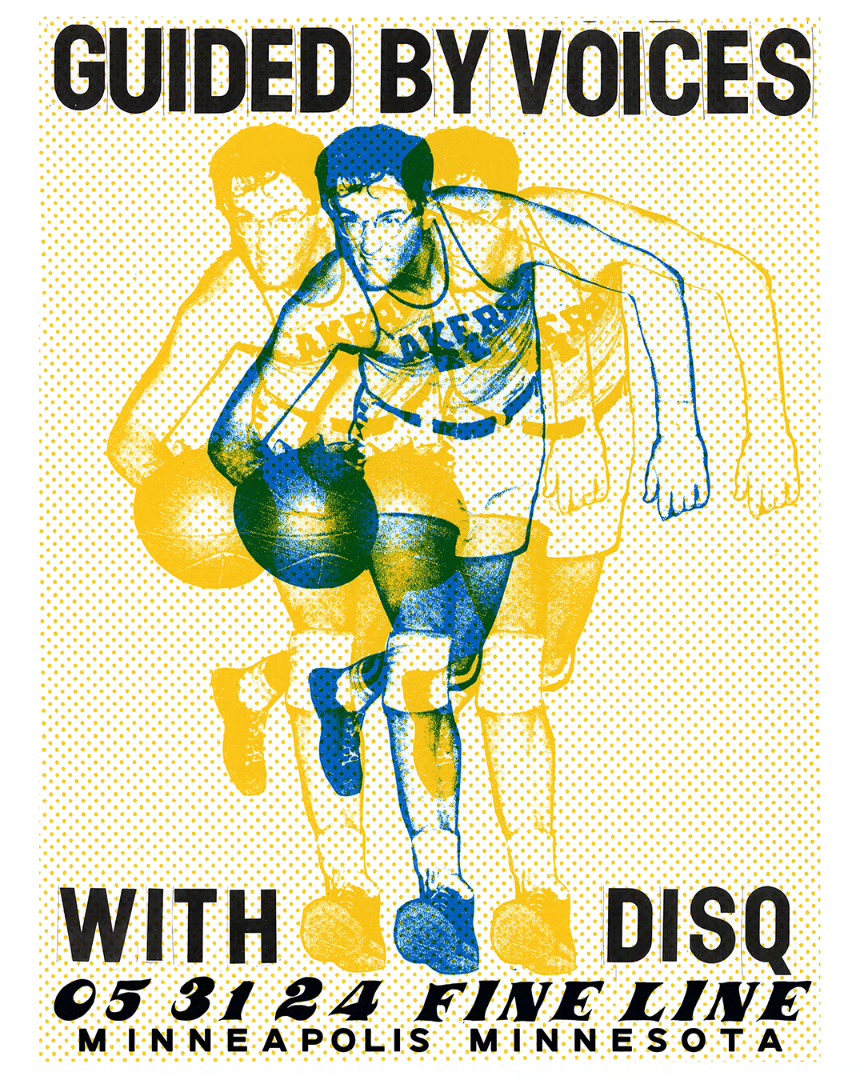
OK, enough music and townie banter! Let’s talk about how you started making posters for bands and how, through some miraculous unseen artistic process, raised it to an art form. Where did it start and how did you go from getting weird with photocopy machines to creating these more complex works of art?
I started making posters when I was in college for Love Onion. We all met in the art department and the band included a couple fantastic illustrators who also did artwork for the band. I think that’s one reason I was drawn to cutting and pasting/collaging for the ones I worked on, not only to have a different vibe than the others I really enjoyed the spontaneity and hand made quality of cutting and pasting, using scratch on letters and messing around with the type was also something I really started getting into. I think studying art in college really helped me in understanding things like composition and color, which I just applied to my poster work, and started using the poles and kiosks as my art galleries. So is it art? I think of them as art, disposable and inclusive, for the people!
I’ll always be grateful to [Cat’s Cradle owner] Frank Heath for giving me so many opportunities to hone my skills as a poster maker. He’s never told me what he wants the posters to look like, which really let me have fun with my imagination and creativity, simultaneously making sure the poster was doing its job as an advertisement. I just wanted to make him, and the band whose poster I was working on, happy with the final product. The fact that he kept on asking me to do more only encouraged me, and to do it better. His taste in music and skills as a club owner also gave me the opportunity to work with some of the best bands of my generation. Also inspiring me to produce work that matched the quality of music coming through the Cradle, and still does. Thanks Frank!
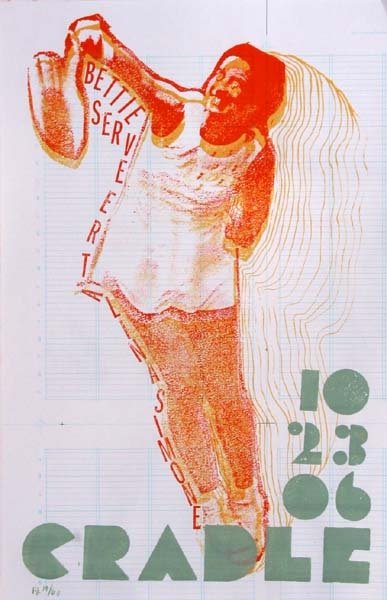
I have always loved how your art drips with pop culture references, skewers conventions and lifts me from the real into a bananas Terry Gilliam-like world of its own. The “punkness” I get from it is the way it questions everything. It’s like it’s naturally suspicious. Is that a fair take? How much of this is intended and how much of it is just your identity spilling out?
I think your take on my work is fair and I appreciate the insight. Terry Gilliam was definitely an influence (humor), along with DaDa (cut and pasted juxtaposition of ideas, type and images to tell a story or convey a feeling), Pop Art (subject matter, screen printed medium, pop culture), the psychedelic poster artists of S.F. in the ’60s (hand lettering, strong fun color).

Where else have you picked up new techniques over the years as you grew into your craft and expanded your palette?
I really liked the film poster work of Saul Bass (keeping it simple, really messing around with type to tell a story) and punk posters of the 70s and 80s (fucked up and photocopied). Some of my contemporary poster people whose work I respected and was inspired by are Art Chantry, Seripop, Zeloot, Dale Flattum, Print Mafia, Mat Daly, Matt Hart, Dead Meat Design, Tannis Root and many many more. I guess I take all of those influences, plus my love of beautiful black and white film, plus growing up on the boardwalks of NJ and all of the hand-painted signage, my love of music, a little bit of humor, a little bit of art knowledge, a little bit of storytelling, sprinkle in an ad man, give me a deadline and now you have one of my posters.

Growing older ain’t all bad. In the early ’90s, you were a scruffy young miscreant making off-puttingly weird concert posters. Now you are a distinguished artist with hundreds of your works featured in UNC’s Southern Folklife Collection. What the hell! At what point did you realize the lasting impact of your work and is it enough to sustain you in your down moments?
I feel I’m just one of a long line of graphic designers telling stories about bands and happenings via the art of the poster. I’m lucky enough to live in such a supportive and vital music and art environment that I’ve managed to have enough work over the years to really hone my craft and am honored that places like the Southern Folklife Collection have acknowledged my work and included some of it in their incredible collection. I’m especially glad that future people will be able to physically touch my posters, which is a much different experience than looking at them on one’s phone.
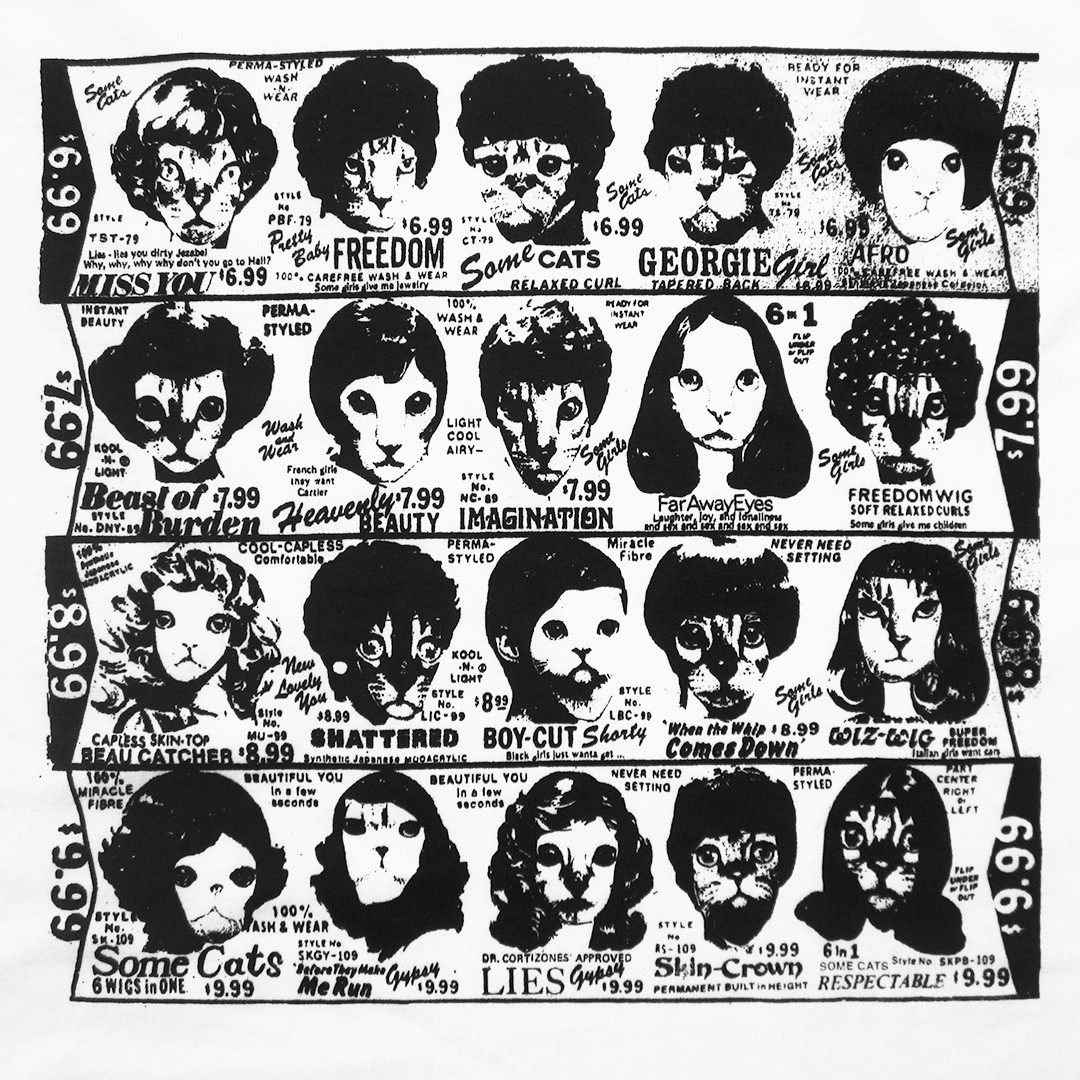
I always cringed at the term “music scene” or, even worse, “scenester.” It sounded shallow and cynical to me, like people trapped in a meaningless pose. I deliberately started using the word “community” in conversations around Chapel Hill long ago and I stand by that.
This community I landed in—and the hundreds of bands and clubs I’ve worked with—have inspired me to be the best, consistent and creative artist I can be. It’s given me my life and how I live it and I’ll be forever grateful for that.
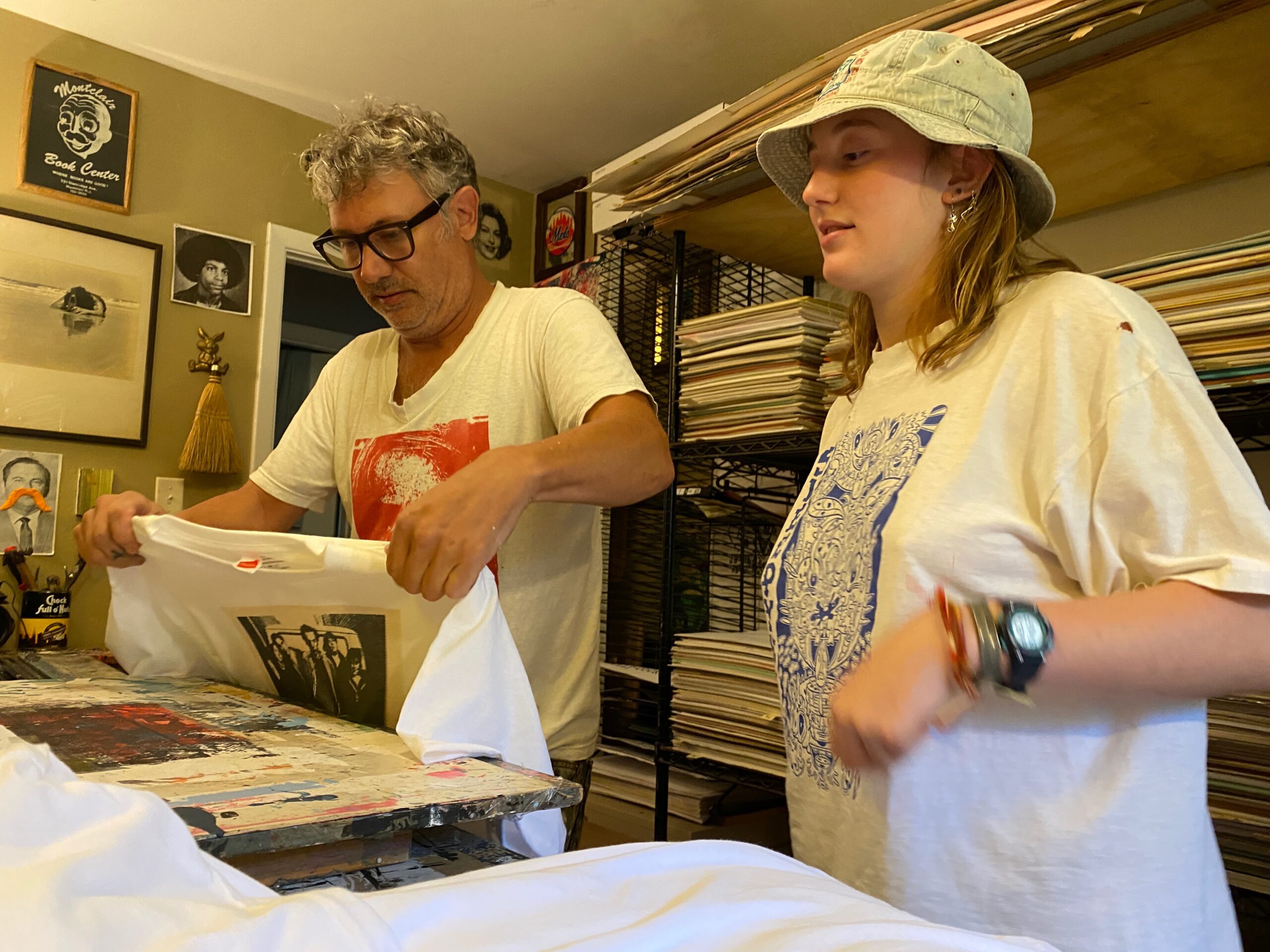
With the benefit of hindsight—and with your upcoming PEEL show in mind—I can now see that people like us are ART LIFERS and true believers. Not “scenesters.” What has the art lifer community you’ve been a part of for more than 30 years meant to you—or even given you—over time?
Being an art lifer means being lucky enough to find something you love to do, and doing it all the time for a long time, not for the money but for the feeling of being part of something bigger than yourself and sharing your skills with others to make this place, and our situation here, better and stronger and smarter for future art lifers. And as far as dedicating this new batch of work … I’m no spring chicken and have been looking back at all the work I’ve done, and the people in my life that have come and gone, some of them now gone forever, and wanted to take a breath and work on new stuff with their spirit and vigor in mind … so I can start my next chapter, making art and music and new friends and colleagues along the way.
Brand-new work from Ron Liberti will be on display at Peel Gallery in Carrboro, NC starting November 5 and running through December 7. Ron will also appear at an opening reception on November 14 from 6–9 p.m.
